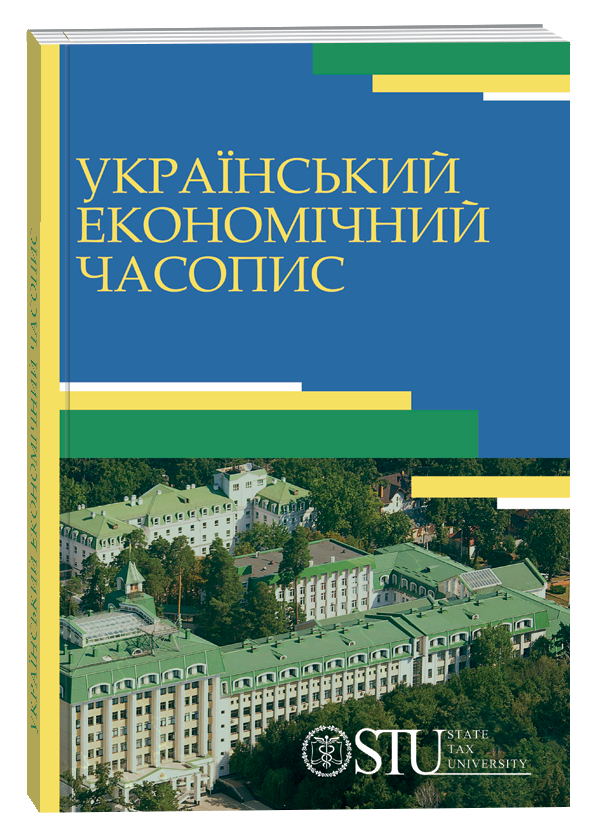PHENOMENOLOGY OF TRANSFER PRICING: DIALECTICS OF TAXATION OF INVESTMENT REAL ESTATE IN THE GLOBAL CONTEXT
DOI:
https://doi.org/10.32782/2786-8273/2025-9-15Keywords:
transfer pricing, investment real estate, taxation, accountingAbstract
Introduction. In the modern globalized economy, transfer pricing has become one of the key instruments of international business, influencing the distribution of profits across jurisdictions and shaping the taxation framework for investment real estate. The relevance of studying this issue is driven by several factors, including the rapid growth of global real estate investments, which complicates financial flows and necessitates effective control mechanisms. Additionally, transfer pricing is often used as a tool for tax burden optimization, sometimes leading to manipulations that undermine fairness and transparency in taxation. Purpose. The study aims to analyze the phenomenology of transfer pricing in the taxation of investment real estate, revealing its socio-economic essence and contradictions in the global context. It seeks to explore the interplay between state taxation policies and investors' interests, particularly in light of international tax standards and regulatory initiatives. Methods. A phenomenological approach is applied to examine transfer pricing as an economic and social phenomenon that emerges at the intersection of state, business, and societal interests. The study also considers dialectical analysis to explore the contradictions between tax revenue maximization by states and cost minimization strategies by investors. Results. The research highlights the dual nature of investment real estate as both an economic asset and a socially significant resource. It reveals the challenges posed by transfer pricing in ensuring tax fairness while maintaining investment attractiveness. Furthermore, the study underscores the growing role of international tax regulations, particularly OECD’s Base Erosion and Profit Shifting (BEPS) initiatives, in promoting transparency and combating tax avoidance. Conclusions. The study confirms the importance of understanding transfer pricing from a phenomenological perspective to develop more effective and fair taxation policies. Given the increasing global emphasis on transparent tax mechanisms, the findings contribute to both theoretical discussions and practical policymaking in the field of investment real estate taxation.
References
Brauner Y. What the BEPS? Florida Tax Review. 2014. Vol. 16, № 2. P. 55–115. URL: https://ssrn.com/abstract=2457256
Clausing K. A. The Effect of Profit Shifting on the Corporate Tax Base in the United States and Beyond. National Tax Journal. 2016. Vol. 69, № 4. P. 905–934. DOI: https://doi.org/10.17310/ntj.2016.4.09
De Mooij R. A., Ederveen S. Corporate Tax Elasticities: A Reader's Guide to Empirical Findings. Oxford Review of Economic Policy. 2008. Vol. 24, № 4. P. 680–697. DOI: https://doi.org/10.1093/oxrep/grn033
Desai M. A., Foley C. F., Hines J. R. The Demand for Tax Haven Operations. Journal of Public Economics. 2005. Vol. 90, № 3. P. 513–531. DOI: http://dx.doi.org/10.2139/ssrn.593546
Dyreng S. D., Hanlon M., Maydew E. L. The Effects of Executives on Corporate Tax Avoidance. The Accounting Review. 2010. Vol. 85, № 4. P. 1163–1189. DOI: https://doi.org/10.2308/accr.2010.85.4.1163
European Commission. State Aid: Ireland Gave Illegal Tax Benefits to Apple. European Commission. 2017. 45 p.
European Commission. Taxation Trends in the European Union. European Commission. 2021. 320 p.
French Tax Authority. Google Fined €1 Billion for Transfer Pricing Violations. French Tax Authority. 2020. 25 p.
Gresik T. A. The Taxing Task of Taxing Transnationals. Journal of Economic Literature. 2001. Vol. 39, № 3. P. 800–838. DOI: https://doi.org/10.1257/jel.39.3.800
Hines J. R., Rice E. M. Fiscal Paradise: Foreign Tax Havens and American Business. The Quarterly Journal of Economics. 1994. Vol. 109, № 1. P. 149–182. DOI: https://doi.org/10.2307/2118431
Kovács A. Tax Policy and Investment in Hungary. Journal of European Taxation. 2020. Vol. 12, № 3. P. 45–58.
Lim S. Real Estate Investment in Asia: Challenges and Opportunities. Asian Economic Review. 2019. Vol. 8, № 2. P. 67–82.
OECD. Transfer Pricing Documentation and Country-by-Country Reporting. OECD. 2015. 120 p.
Singapore Tax Authority. Property Tax Rates in Singapore. Singapore Tax Authority. 2021. 45 p.
Slemrod J., Wilson J. D. Tax Competition with Parasitic Tax Havens. Journal of Public Economics. 2009. Vol. 93, № 11–12. P. 1261–1270. DOI https://doi.org/10.1016/j.jpubeco.2009.08.004
Spanish Tax Authority. Cancellation of Tax Incentives for Real Estate Investors. Spanish Tax Authority. 2019. 15 p.
UK Government. Tax Relief for New Builds. UK Government. 2021. 30 p.
U.S. Department of the Treasury. Opportunity Zones: Annual Report. U.S. Department of the Treasury. 2021. 80 p.
U.S. Department of the Treasury. State and Local Tax Rates. U.S. Department of the Treasury. 2021. 120 p.
Податковий Кодекс України : Закон України від 02.12.2010 № 2755-VI (зі змінами і доповненнями). Вебпортал Державної податкової служби України. URL: https://tax.gov.ua/zakonodavstvo/podatki-ta-zbori/zagalnoderjavni-podatki/plata-za-zemlyu--fizichni-oso/normativno-pravovi-akti/63224.html (дата звернення: 11.04.2025).
Brauner, Y. (2014). What the BEPS? Florida Tax Review, vol. 16 (2). Available at: https://ssrn.com/abstract=2457256
Clausing, K. A. (2016). The Effect of Profit Shifting on the Corporate Tax Base in the United States and Beyond. National Tax Journal, vol. 69 (4), p. 905–934. DOI: https://doi.org/10.17310/ntj.2016.4.09
De Mooij, R. A., Ederveen, S. (2008). Corporate Tax Elasticities: A Reader's Guide to Empirical Findings. Oxford Review of Economic Policy, vol. 24 (4), p. 680–697. DOI: https://doi.org/10.1093/oxrep/grn033
Desai, M. A., Foley, C. F., Hines, J. R. (2005). The Demand for Tax Haven Operations. Journal of Public Economics, vol. 90 (3), p. 513–531. DOI: http://dx.doi.org/10.2139/ssrn.593546
Dyreng, S. D., Hanlon, M., Maydew, E. L. (2010). The Effects of Executives on Corporate Tax Avoidance. The Accounting Review, vol. 85 (4), p. 1163–1189. DOI: https://doi.org/10.2308/accr.2010.85.4.1163
European Commission. (2017). State Aid: Ireland Gave Illegal Tax Benefits to Apple.
European Commission. (2021). Taxation Trends in the European Union.
French Tax Authority. (2020). Google Fined €1 Billion for Transfer Pricing Violations.
Gresik, T. A. (2001). The Taxing Task of Taxing Transnationals. Journal of Economic Literature, vol. 39 (3), p. 800–838. DOI: https://doi.org/10.1257/jel.39.3.800
Hines, J. R., Rice, E. M. (1994). Fiscal Paradise: Foreign Tax Havens and American Business. The Quarterly Journal of Economics, vol. 109 (1), p. 149–182. DOI: https://doi.org/10.2307/2118431
Kovács, A. (2020). Tax Policy and Investment in Hungary. Journal of European Taxation, vol. 12 (3), p. 45–58.
Lim, S. (2019). Real Estate Investment in Asia: Challenges and Opportunities. Asian Economic Review, vol. 8 (2), p. 67–82.
OECD. (2015). Transfer Pricing Documentation and Country-by-Country Reporting.
Singapore Tax Authority. (2021). Property Tax Rates in Singapore.
Slemrod, J., Wilson, J. D. (2009). Tax Competition with Parasitic Tax Havens. Journal of Public Economics, vol. 93 (11–12), p. 1261–1270.
Spanish Tax Authority. (2019). Cancellation of Tax Incentives for Real Estate Investors.
UK Government. (2021). Tax Relief for New Builds.
U.S. Department of the Treasury. (2021). Opportunity Zones: Annual Report.
U.S. Department of the Treasury. (2021). State and Local Tax Rates.
Verkhovna Rada Ukrainy. (2010). Podatkovyi kodeks Ukrainy [Tax Code of Ukraine]. Available at: https://tax.gov.ua/zakonodavstvo/podatki-ta-zbori/zagalnoderjavni-podatki/plata-za-zemlyu--fizichni-oso/normativno-pravovi-akti/63224.html



